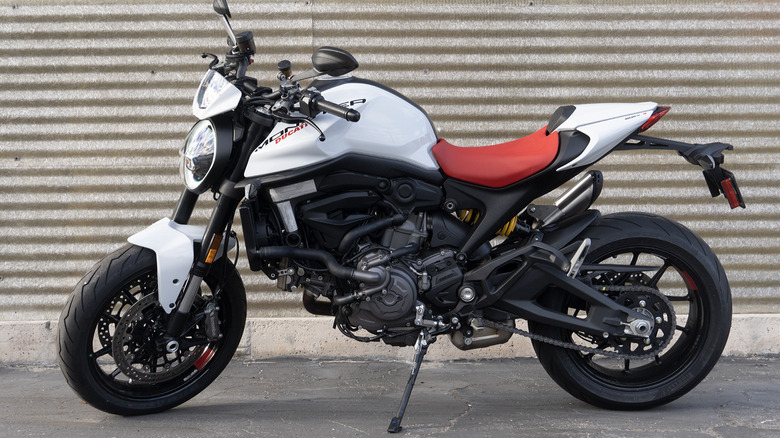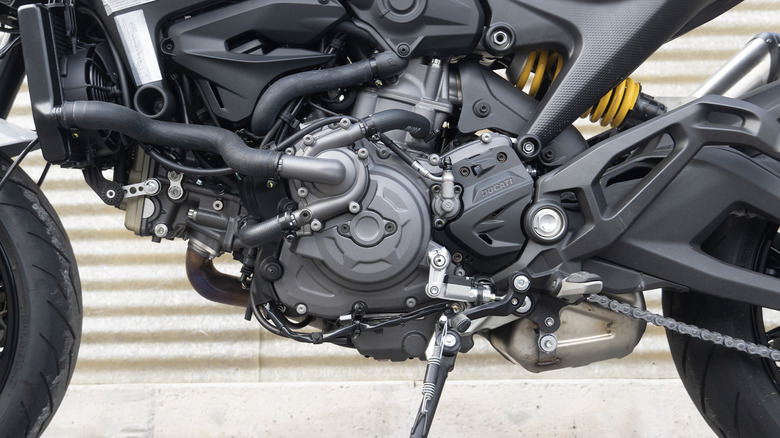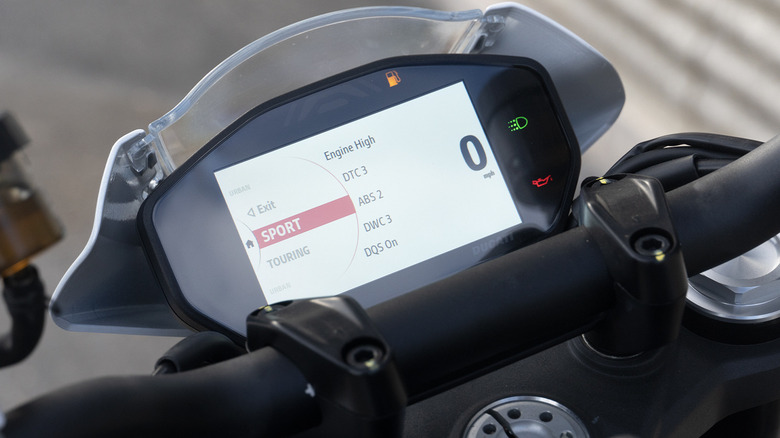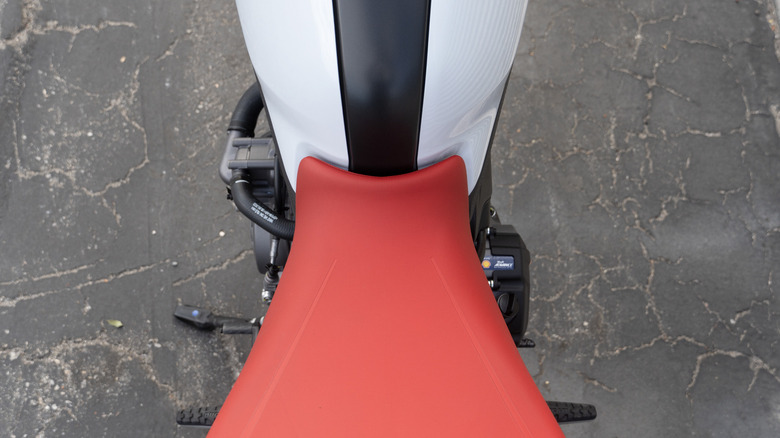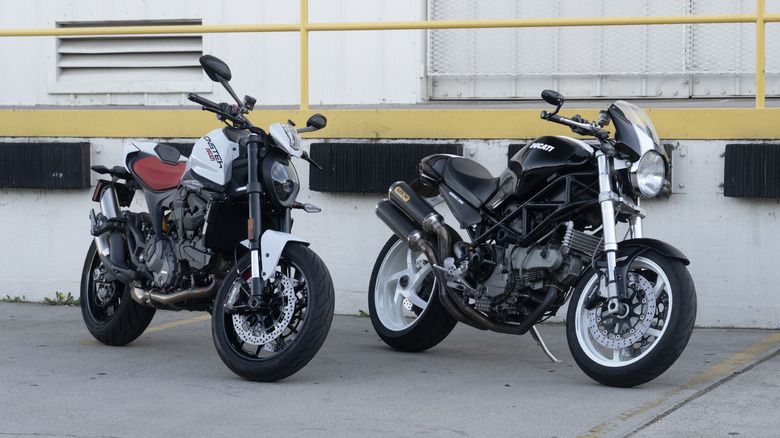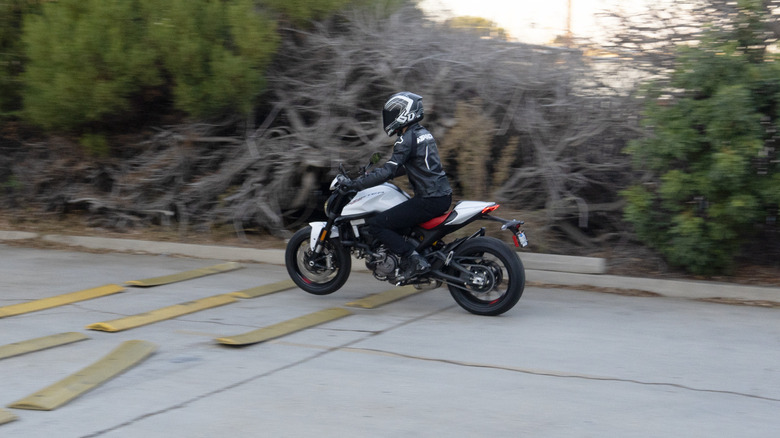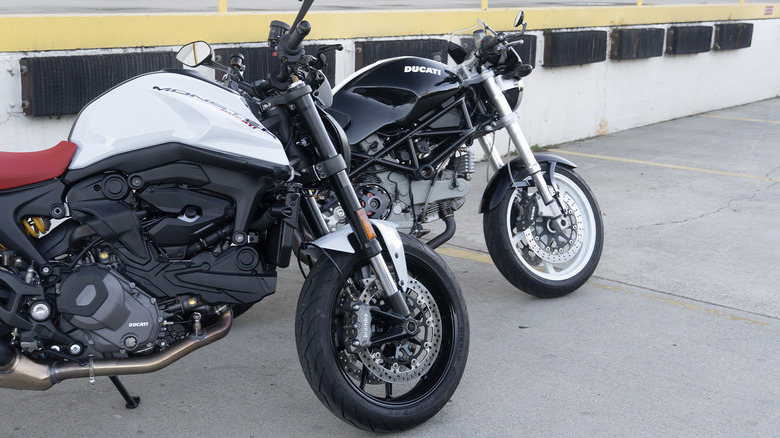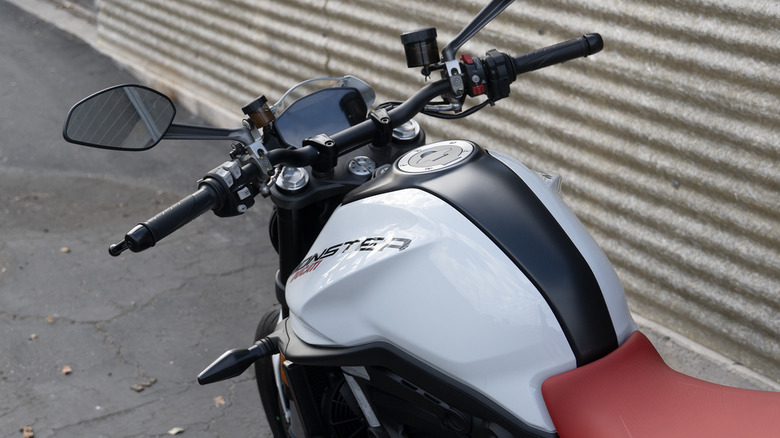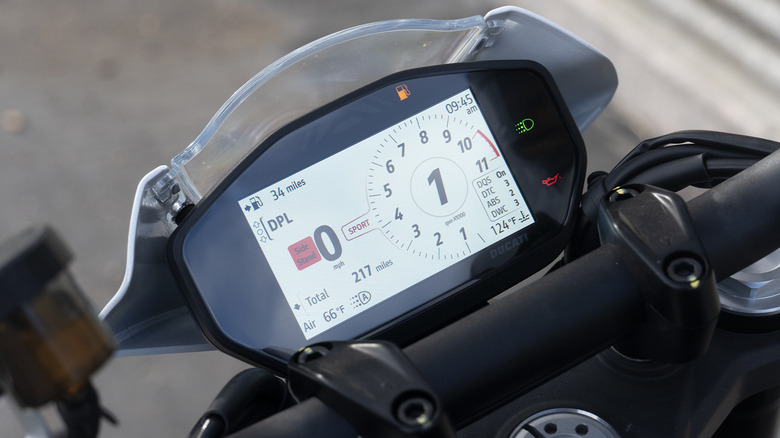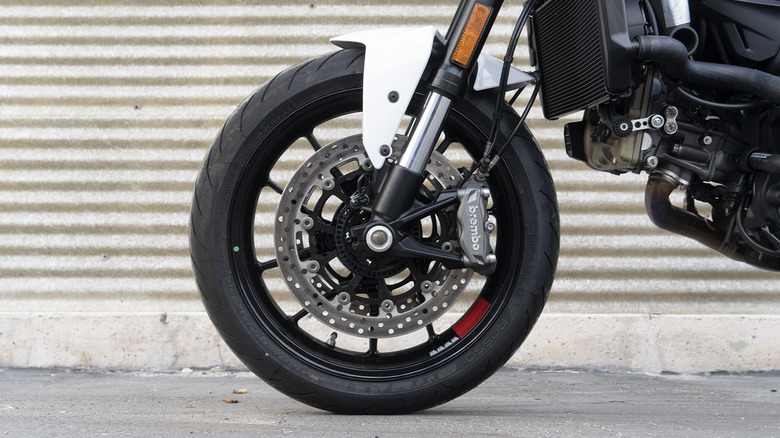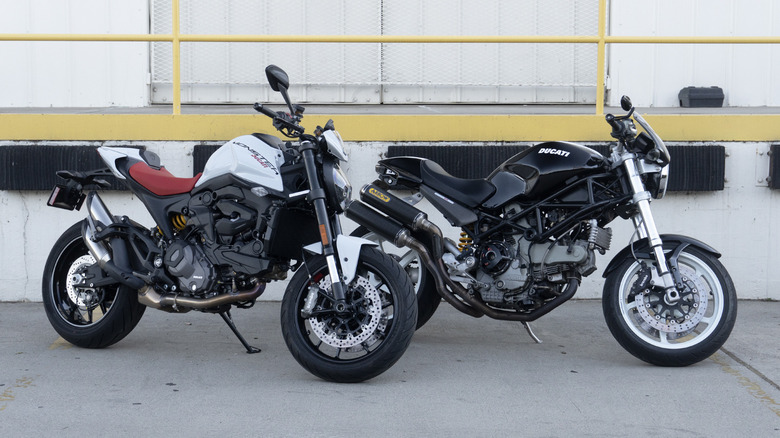2024 Ducati Monster Plus Review: Does This Modern Starter Bike Exceed Expectations?
- Lightweight and nimble for the new generation
- Easy to either commute or push hard
- Full electronic suite despite entry-level pricing
- More reliable and durable than previous Monster generations
- Loses the Monster's iconic trellis frame
- Monster "Plus" only adds a tiny windscreen and pillion cover
- No high-horsepower variant
The original Ducati Monster debuted in 1993 as an affordable parts-bin special that would go on to both define and popularize the naked motorcycle genre. More than three decades later, the Monster has now entered a third generation as Ducati's entry-level water-cooled bike, with a starting price tag of $12,995. Only the air-cooled Scrambler sits lower on the Ducati ladder currently, though many fans believe the new Monster has lost the original's undeniably iconic status.
As fate would have it, I just happened to pick up a 2006 Monster S2R 1000 last month, one of the later air-cooled Monsters that typifies the raw, gnarly personality that slowly began to evaporate in later years. Just a week after I bought that S2R, Ducati dropped off this brand-new Monster Plus painted in Iceberg White for me to test on the streets and in the canyons of Los Angeles.
Easy to ride and perfect for beginners, the new Monster still delivers enough pep and exotic appeal to attract experienced riders, too. As I quickly discovered, no matter how much longtime Monster fans such as myself might bemoan the loss of the iconic exposed trellis frame, the modern iteration is undeniably a better bike and serves as another example of the massive strides Ducati has taken in engineering and reliability under Volkswagen AG ownership.
A Monster for the modern era
That Iceberg White paint arrives fresh for the 2024 model year, but otherwise the Monster remains unchanged since the generational update in 2021. Cradled in the new aluminum truss chassis, a 111-horsepower 937cc Testrastretta L-twin carries over from the Hypermotard and Supersport 950 boasting a narrower waist, with the saddle moved forward and the handlebars moved higher and rearward to match.
The geometry and a dry weight of only 366 pounds makes the new Monster feel feathery and nimble, while most riders will comfortably fit on the 32.3-inch high seat. The geometry creates an upright posture perfect for improved visibility in traffic, but the narrow seat and engine also make the Monster easy to flat foot at stop lights. Clearly, commuter priorities fit into Ducati's R&D process, as proven by the lightweight clutch action and smooth quickshifter that can whip through gears without even needing to hit high revs or full throttle first.
A perfect commuter or beginner bike
Beginner riders will appreciate Ducati's ride modes, which allow for adjustment of the throttle response, especially, to help smooth out any accidental yanks of the right wrist. Soft suspension helps to provide a stable base and large, tactile switchgear only takes a few moments to begin working confidently without needing to glance down.
I rode the Monster to run errands and visit friends around Los Angeles for a couple of afternoons before heading up for a real rip in the canyons. Switching into Sport mode on the Pacific Coast Highway noticeably ratcheted up the Testrastretta engine's eager revs, though I kept most of the nannies engaged hoping not to slide out after recent rainstorms left my favorite roads strewn with rocks, sand, and chaparral debris.
Canyon carving on the new generation Ducati Monster
I still hit a rhythm on the Monster Plus pretty quickly, that narrow waistline highlighting the ease with which I scooted off the saddle and hooked the crook of my knee while leaning out on tighter corners. For public roads, the Testrastretta's peppy 111 ponies and wide torque band, with 69 lb-ft available at 6,500 rpm, makes for just about the perfect power-to-weight ratio in my opinion, just enough to hit full throttle regularly but never outrun my hind legs.
And yet, an amateur rider such as myself definitely felt the Monster's limits approaching soon, or at least my own limits on the bike given the road surface and a growing comfort level. Leaning out from such an upright position always keeps me from pushing too much harder, because I tend to prefer sportier clip-ons or at least lower canted handlebars.
The OG Monster appeal
Riding my S2R and the new Monster Plus back-to-back brings my motorcycle life into a full circle, ever since the day I first saw an early Monster while visitig Italy in fourth grade. At the time, my young self never even knew naked bikes even existed as a category—seeing that black trellis frame roaring by repeatedly in raging Milanese traffic left me dumbstruck and drooling, so much so that lust for a Monster stuck in mind even all these years later.
After riding dirt bikes and climbing on the back of my dad's Yamaha as a kid, then stepping away from motorcycles for about 25 years, I finally decided to make the commitment to earning my M1 endorsement almost two years ago. Part of the motivation came from a need to avoid traffic at Monterey Car Week (where I rode a Monster Plus in 2022), but a significant portion of the urge also stemmed from that original Monster sighting in Italy. So when the time came to buy my own bike after a string of loaners, I faced only one obvious choice. And it had to be black.
Such is this monstrous hold on me, the origin of Ducati mythos in my mind. Why did it take me so long? Mostly concerns about legendary reliability—or lack thereof—over the years. Valve clearance checks required every 7,500 miles for desmodromic air-cooled engines still give me pause, though the S2R 1000's late-model 993ci L-twin is widely regarded as one of the most refined and reliable air-cooled twins in Ducati's history.
Hooked on the classics
But I also wanted to ride more bikes and figure out what attributes I like most before leaping into a purchase. And having ridden almost all of Ducati's modern lineup by now, one major lesson has been just how much the tiniest differences in geometry can make a big difference in how much I enjoy a bike. Plus, the great strides in mechanical reliability that Ducati has taken under Volkswagen AG, with the desmo service interval on a new Monster now up to 18,000 miles, made a new water-cooled bike with modern switchgear and electronics and transmissions very appealing.
Then I rode an S2R 1000 and the gig was up. The older bike's stats actually look somewhat similar on paper to the new Monster Plus, at 95 horsepower with a 10,000-rpm tachometer and a dry weight of 392 pounds. But the experience is undoubtedly more rough and tumble, all clattery dry clutch, real muscle required to work the clutch and gearshift levers, audible brake pads clamping down on dual Brembo front discs. The S2R 100 nails a satisfying level of mechanical engagement almost akin to rowing gears on a perfectly sorted air-cooled Porsche.
Little details stand out side-by-side
Looking at the 2006 Monster and the 2024 Monster Plus on their kickstands next to each other, the evolution in style stands out immediately. Notably, what Ducati calls the "Bison" humped fuel tank and more clearly styled plasticene engine covers around the aluminum truss. A bunch of hoses and wires and radiators and exhaust details remain visible, but the S2R's higher pegs, lower tank, and further forward handlebars—not to mention the cafe racer-esque windscreen—all contribute to a sportier spirit despite my Monster's relative age.
My first S2R ride up into Malibu revealed more major differences than expected. On my own bike, my very first road-going motorcycle purchase, I wanted to ease into the zone before pushing anywhere near the edge. But still, even with an aftermarket lithium-ion battery, the additional poundage reared its head immediately. I found full throttle regularly once the oil fully warmed up, coaxing everything out of the older bike's additional few cubic centimeters despite never quite finding redline up a hair past 8,500 RPM.
Little details on my otherwise perfect S2R 1000
The jump from twin-spark ignition at full throttle to overrun and then rolling back into engine braking also prompted less actual use of the Brembo brakes than I expected. The Showa forks and rear coilover damper that the previous owner tuned to handle a slightly heavier rider delivered my ideal ride quality, ride on the edge of taut without ruining my day on rougher roads.
For me, even the OEM handlebars, despite being lower than on the Monster Plus, still felt slightly too high, so my regular Google searches at home now include a solution for clip-ons or, more likely, a set of sportier aftermarket bars. No bike is perfect, I know, but for a blend of old-school style and relatively modern performance, my S2R fits the bill pretty much perfectly for me.
Refined, if perhaps not quite related
The new Monster drags me into the modern era, though, with all the info available on the digital 4.3-inch gauge cluster. A central gear selection indicator ringed by the tachometer will help beginner riders keep track of shifts better than my S2R's lone green N light for Neutral (even if finding neutral from either first or second is much easier on my bike). Choosing between Sport, Touring, and Urban ride modes quickly adjusts the engine response, traction control, anti-lock brake engagement, wheelie control, and the quickshifter. The coolant temp readout tends to hover at slightly lower levels than my S2R's oil temp, while the fuel remaining and even an ambient air temperature display both come in handy for the nerd in me keeping an eye on numbers and figures.
In terms of ride quality, the new Monster scoots along on city streets much more smoothly than the S2R. The softer forks and rear damper allow for manual adjustment, but their factory settings absorbed speed bumps without disturbing my balance and even braking hard never produced too much nosedive. The more refined throttle reponse also makes the new bike easier to jump on and crank through traffic, not to mention much safer—especially in wet or slippery situations thanks to the traction control and lean-sensitive ABS that my S2R entirely lacks.
Advantages of abandoning the trellis frame
The new bike is also much less likely to be totaled by insurance if it gets dropped. My Monster's trellis frame might look beefy and sturdy but turns out, is actually very easily damaged to the point where repair work simply isn't worth the payout because values of even the higher-spec older Monsters rarely climb much above $10,000 (part of the reason I could actually afford one). And insurance should always fit into the equation for new riders, especially in states like California where many companies will fight tooth and nail not to provide coverage.
Meanwhile, the new bike comes with a 24-month and unlimited mileage warranty to back up that improved reliability, which only enhances the appeal of relatively affordable, undeniably impressive motorcycles like the new Monster. Though, being fair, the Monster Plus trim comes across as something of misnomer since a $200 option package simply adds the rear pillion pad cover and teensy front windscreen—both slightly reminiscent of the S2R 1000, but that windscreen does much less to prevent buffeting at freeway speeds (or faster).
The new generation also dropped a higher displacement, more powerful Monster from the Ducati lineup. And at 95 horsepower for the S2R 1000 way back in 2006, the new bike's 111 ponies can't quite keep up with inflation. Sure, the base 2006 Monster 695 only put out 73 horsepower at 8500 RPM—and rest assured that this Monster Plus will hit triple-digit speeds with ease—but Ducati probably expects riders looking for a bit more fear to step up onto a Streetfighter V2 or V4.
Finding the right bike can be a process
Even the base Streetfighter V2, at 153 horsepower and just 392 pounds dry, delivers a much more hardcore riding experience. In some ways, the Streetfighter almost carries the original Monster's mantle in the modern era, despite also lacking the trellis frame. At the very least, its more lowslung geometry and more substantive controls require a bit more effort to work through in similarly satisfying fashion as my S2R.
The Monster Plus might get some of that choppy L-twin action back into the picture with an aftermarket exhaust or the Termignoni setup offered on the more track-focused Monster SP package. Mine would definitely need a tail tidy and a set of lower, more aggressive handelbars—and I'd still be a long way from stepping up into the territory of a base Streetfighter V2 at $18,195.
The whole point here is providing Ducati fans a price point that makes it easy to bring their own exotic motorcycle fever dreams to life. Though I paid less than half the cost of a new Monster for my turnkey S2R 1000 with 16,000 miles on the odometer, I can fully acknowledge that those monstrous memories played a big part in the decision-making process. And I can fully admit that the more reasonable choice, without a doubt, would have been to buy a new Monster instead.
